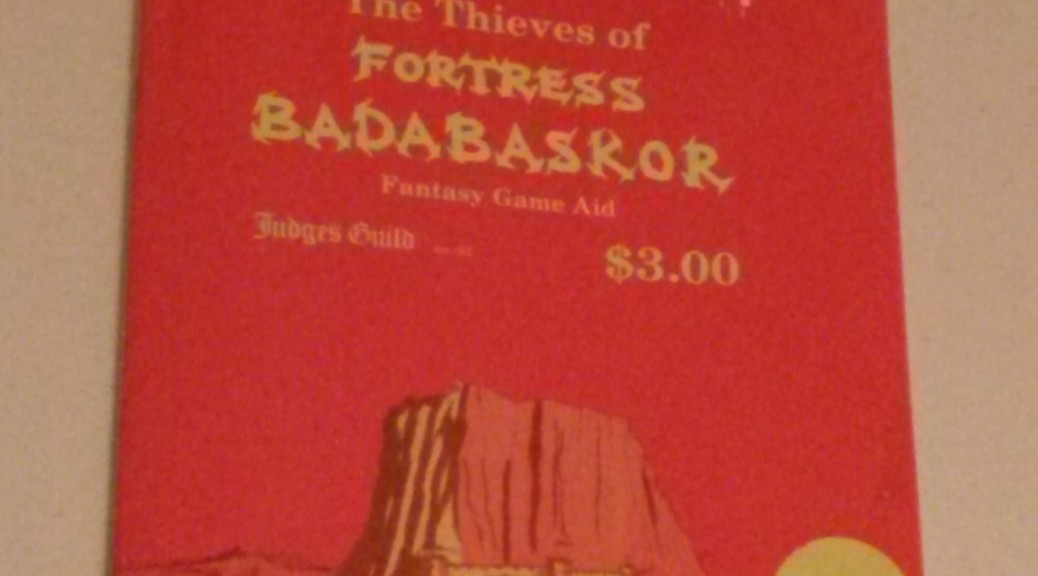I received a review copy of The Thieves of Fortress Badabaskor, a softcover reprint of the Judges Guild module, including printings 1-4 and some new material. This is a portion of the Judge’s Guild Deluxe Colector’s Edition. The deluxe edition will be a hardcover over sized book, but the various parts can be purchased separately in softcover. You can get a PDF of the original here.
This reprint uses the same cover as the first printing, and a sample of the cover for each printing is on the inside back cover.
I must confess that back in the day, my brother and I judge the products from Judges Guild unfavorably, and for not good reasons. We judged the books by their covers, and not the quality of their information. Thus, until the internet showed me what helpful information and tables Judges Guild had, I was ignorant of many of their good ideas.
One major example is Ready Ref Sheets. It has many helpful tables for assisting a DM with various aspects of game prep.
Fortress Badabaskor is a town, fortress, and four level dungeon. It has a backstory, intrigue and can easily fit into an existing campaign. This town could prove to be a base of operations for adventurers even after they had delved the depths beneath Badabakor. In the 40 pages of this mini setting/module are 8 maps showing the surrounding area, the town, and the dungeon levels with a side-view of the elevation.
Judges Guild uses a stat block that I could figure out easily, except for one thing. CLASS, ALIGN, LVL, HTK, AC, SL, S, I, W, CON, DEX, CHAR, WPN. On my first skim through, HTK had me scratching my head until I started over and read it. An earlier NPC spelled out Hits To Kill, which is used instead of Hit Points/HP. Why, I am not sure. I am sure there are those out there who can comment and enlighten the rest of us. Thus remains the bit I don’t understand, SL. I managed to find this link via a google search, and SL is Social Level. It is an interaction mechanic for encounters. That is something that would be good to define in a re-print that can stand alone. If not for the internet, I would have to find someone with the answer to what this is. Now how does this mechanic work? Which book explains that?
[EDIT: Thanks to +Guy Fullerton for pointing out that a list of these abbreviations and their definitions are at the bottom of the table of contents page.]
Before the room descriptions for level one, is this note, and thus a key to what Old School was/is. “Note that each dungeon chamber has a recommended description and some alternate descriptions have been provided to assist the designing judge. Please alter these to suit you campaign!” [emphasis added]
The “designing judge”. That is a helpful turn of phrase. To me, it implies that this setting/module is just an outline for an idea that the GM can modify in whole or in part to suit the campaign. Too many people get on the path of “this is he way it must be”, and lose site of the ability to improvise and shape it to meet the situation.
I really like the alternate descriptions that one can choose to use in place of the ones already there. In some ways, one can mix and match the descriptions in a lot of old school dungeons and not impact much how they play.
Between the town description and the dungeon levels is a table for generating random traps. Like a lot of similar tables from Judge’s Guild, like Ready Ref Sheets, there is a percentile roll to determine the type and then a series of 1d6 tables to further define that trap. There are lots of sub-categories used to flesh out various aspects of traps that get one to think about the depth of such tables, and not just a large number of one line traps. This is a concept akin to story dice that give you words and phrases that you can use to build a description of a trap.
The final eleven pages are a supplement added by Goodman Games, by Michael Curtis. It goes into more detail about some things on level three, and presents some factions for level 4.
Since this is designed with D&D in mind, it is generic enough within that mold to work with little or no modification for various clones. It could even be used for ideas for use with different genres.
The last four pages are re-prints of the ads for various Judges Guild products and sending in S.A.S.E.’s and your money to have it mailed right back to you. That brings up memories and gives a taste to the younger generations how things were before about 15 or 20 years ago.
One thing I soon noticed, on an earlier page halflings are mentioned, and later it mentions hobbits. Seems like the Tolkien estate may not have gone after Judges Guild as stridently as it did TSR over the use of hobbit.
This volume is of much heavier stock than the original such, as I remember them. The pages and cover and slick and shiny. The shininess makes certain angles in some light wash out the test, but otherwise it is very legible.
This is $19.99 from Goodman Games, a PDF of the third printing is on DriveThruRPG/RPGNow for $3.99, which does not have the new material. If $20.00 plus shipping is too much for you, and you can use the PDF, you have options. There are also periodic sales and so forth that can make it easier to dive in.
I have some ideas for how I might use this. Mashed potatoes and aliens anyone?


